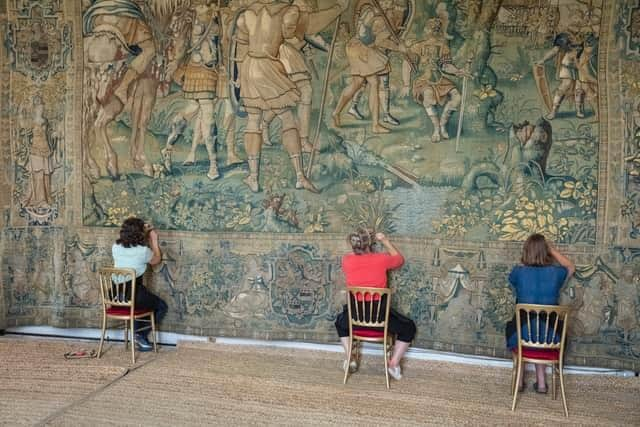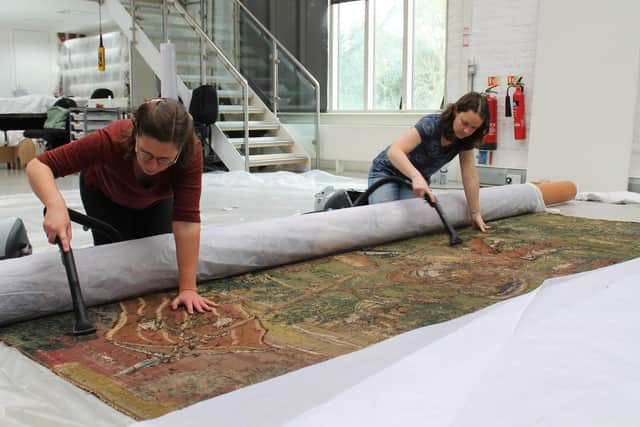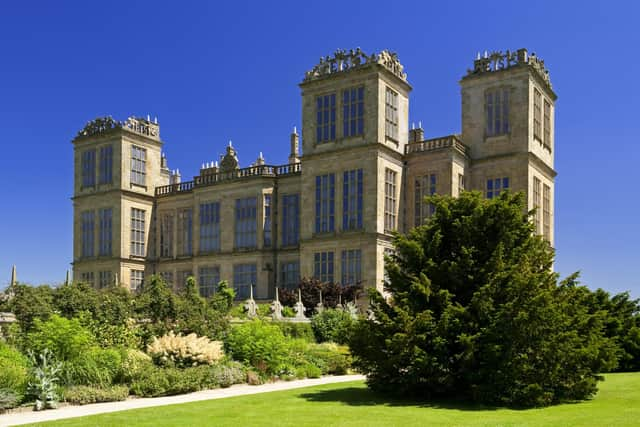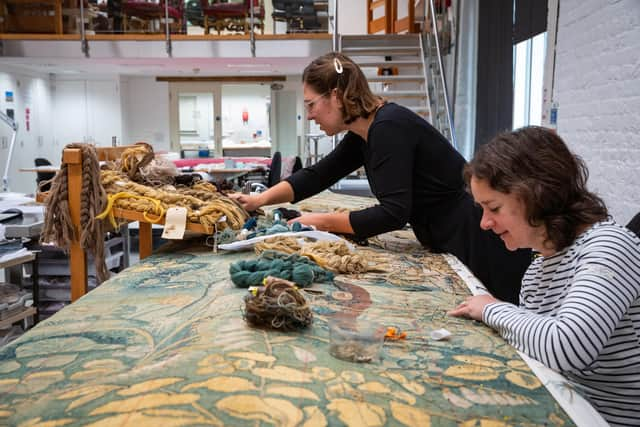Historic Derbyshire tapestries measuring over 70 metres long are restored over 24 years and 5,000 hours of work
and live on Freeview channel 276
The project is the most significant restoration project undertaken in the history of the National Trust.
After 24 years and 5,470 hours of stiching, lining and reconstructing, the final tapestry in a set of 13 has been rehung at Hardwick Hall.
Advertisement
Hide AdAdvertisement
Hide AdA status symbol for the likes of Bess of Hardwick (1521 - 1608) - who bought the tapestries for £326 15s 9d - today they have been brought back to life following a £1.7 million project.


Since 1592, the tapestries depicting the story of Gideon - one of the 12 Judges from the Old Testament - has hung in he Long Gallery at Hardwick Story. The story follows Gideon as he leads an army to save his peple from the Midianites.
The tapestries are the largest surviving set in the UK and is considered one of th emost ambitious of its time - measuring more than 70 metres in length.
Property Curator at Hardwick Hall, Liz Waring, said: “This is the most significant restoration project of the whole 120 years of the National Trust.
Advertisement
Hide AdAdvertisement
Hide Ad“I think the tapestries still hold significance today because they tell us how people wanted to represent themselves in the past and how they would essentially show off their wealth. Bess of Harwick has not only shown her weath with the tapestries but her religion too.


“It also shows us how people made things in the past.”
The tapestries were originally woven in 1578 for Lord Chancellor Sir Christopher Hatton for Holdenby House in Northamptonshire. After his dath, they were sold to Bess of Hardwick.
The National Trust’s Senior National Curator Emma Slocombe said: “These astonishing tapestries have been in the Long Gallery since it was first decorated at the end of the 16th century. Extraordinarily, that’s where they remain. Bess collected them and unlike many tapestries they’ve never been moved to another home, dispersed or cut up.
“Everything at Hardwick is pre-eminent and these tapestries are unique, an ambitious statement at the heart of an architectural masterpiece.


Advertisement
Hide AdAdvertisement
Hide Ad“As one of the richest women in England, when she planned her decorative schemes, she was thinking about what they could convey about her and her lineage. The Gideon tapestries were designed to be seen, as well as enjoyed privately.”
The conservation of each of the tapestries took more than two years to complete. Like the 12 tapestries before it, the 13th was thoroughly vacuum cleaned to remove loose fibres, soiling, dust and soot and then documented in detail before being sent to Belgium for specialist wet cleaning.
National Trust conservators used specialist conservation stitching – with hand-dyed yarns – to repair damaged areas, improve the appearance of 20th-century reweaves, and strengthen the structure of the tapestry. Its three sections were then reconstructed and lined to prevent dust penetrating the back.
To maintain consistency, precise records were kept, including ‘recipe books’ with instructions on how to make bespoke dye colours for the threads.


Advertisement
Hide AdAdvertisement
Hide Ad‘Stitch guides’ were also used to ensure stitches were correctly spaced to achieve the desired effect, and so that they can be discerned from original stitches.
Texile Conservator Yoko Hanegreefs added: “Our conservation work secures the future of the tapestries for at least 100 years. Being able to safeguard these beautiful and important tapestries for future generations gives us as conservators a great sense of achievement.”
Following the tapestry’s rehanging at Hardwick Hall, visitors can see the extraordinary set reunited for the first time in nearly 25 years.
This conservation of the tapestries was made possible over many years through funding from The David Webster Charitable Trust, the Wolfson Foundation, the Royal Oak Foundation, National Lottery Heritage Fund and other charitable trusts and foundations - as well as individual donors.